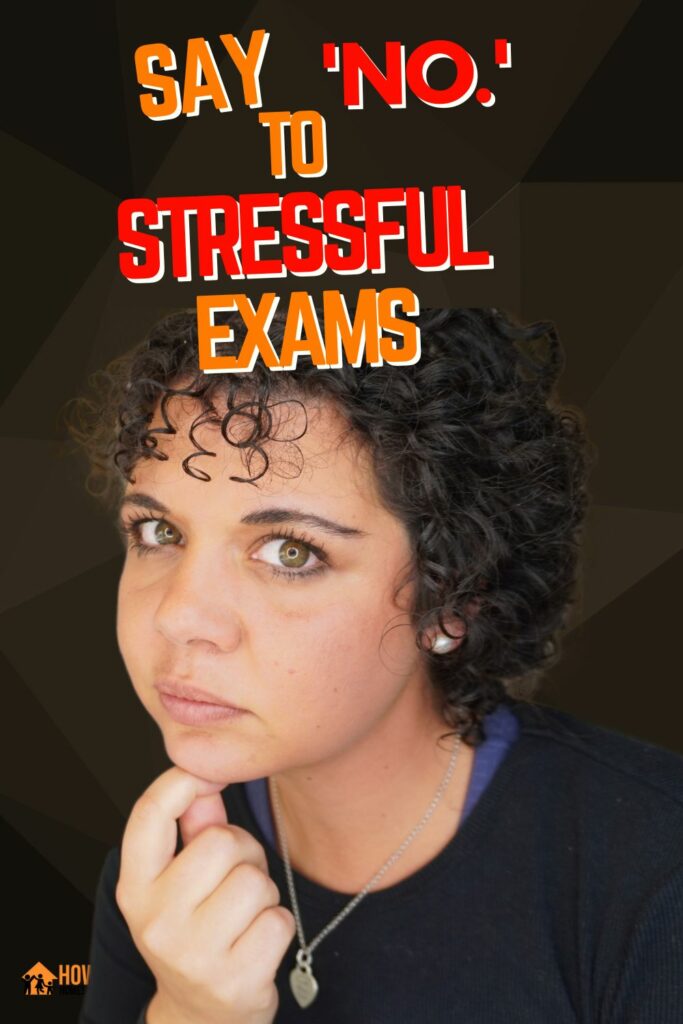In a world obsessed with exams, it’s high time we question their value and the toll they take on our children when they’re made into stressful, all-important affairs. Why do parents put their kids through stress? Is it really for their benefit, or is there something more at play? From a homeschooling perspective, let’s delve into the fascinating world of “Stressful Exam-O-Nomics” and unveil the illusion of academic success that keeps students and parents trapped in a cycle of pressure and anxiety.

Affiliate links used in this post.
The Government’s Stressful Exam Mania
Let’s face it; exams have become the government’s favorite yardstick to measure the performance of our education system.

I hope you enjoy reading this blog post. If you want to do my course on how to homeschool, click here.
They see it as a straightforward way to assess students’ knowledge, or at least what they remember during a pressure-packed event.
But does a one-size-fits-all exam really capture the essence of learning?
Unfortunately, it often falls short.
For example, government tests usually test for the three R’s; but they very rarely test practical skills. Therefore, we end up with a warped view of children and only seem to value intelligence in academic areas.
Learning for the Test, Not for Life
In the race for top scores, genuine learning takes a backseat.
Students, driven by the looming exam dates, become masters of cramming and memorization.
Instead of fostering creativity and critical thinking, exams sometimes only encourage the regurgitation of information, leaving little room for personal growth and interest-based education.
In this twisted scenario, education becomes a sprint rather than a marathon.
When exams are a stressful affair, children can no longer enjoy the caterpillar and butterfly for the wonderful God-given treasures they are. Now they have become part of a lifecycle, one that children have to learn and cram for. The caterpillar loses its charm, and the butterfly becomes just an image between the cocoon and the eggs.
Stressful Times and Strained Parent-Child Relationships
If exams are stressful, stress levels skyrocket as exams creep closer. They transform our gorgeous little children into sleep-deprived, anxiety-ridden beings.
They turn into bundles of nerves, and who ends up absorbing the brunt of their frustration?
The poor parents!
It’s like getting caught in the crossfire of a rebellious teenager’s angst and an overwhelmed scholar’s meltdown.
The Real Lessons in Life
Now, picture a world where kids are free from exam-induced anxiety.
A world where they learn at their own pace, driven by curiosity, passion, and love for knowledge.
Homeschooling, with its flexible and tailored approach, embraces this very vision.
It allows children to explore a wide range of interests, nurturing their talents and strengths beyond the narrow scope of standardized tests.
Alternative Assessments for Real Learning – No Stressful Exams
So, what’s the solution?
Are exams the unavoidable gatekeepers of educational progress?
Not necessarily.
In the homeschooling realm, we have the luxury of exploring alternative assessment methods.
Projects, presentations, portfolios, narration, and real-world applications can offer a more holistic evaluation of a child’s growth, creativity, and problem-solving skills.
Let’s go through each of these alternative testing/assessment methods in more detail below.
Projects
Projects involve hands-on activities or research-based assignments that allow students to explore a topic in depth.
They encourage creativity, critical thinking, problem-solving, and independent learning.
Unlike traditional exams, projects provide opportunities for students to apply their knowledge in practical ways, fostering a deeper understanding of the subject matter.
Example: For a science project, students could design and conduct experiments to explore a specific scientific concept, such as the effects of different variables on plant growth. They would gather data, analyze the results, and present their findings in a visual format, such as a poster or a multimedia presentation.
Presentations
Presentations require students to communicate their knowledge and ideas in a structured manner.
By presenting information to their peers or teachers, students develop public speaking skills, boost their confidence, and enhance their ability to articulate thoughts effectively.
Presentations also promote research skills, organization, and the ability to engage an audience.
Example: Students could deliver a presentation on a historical figure, discussing their significance and impact on society. They would research the individual, create a slideshow with key information, and deliver a well-structured and engaging presentation to their peers and teacher.
Portfolios
Portfolios are collections of students’ work demonstrating their progress and achievements over time.
They can include various forms of assessments, such as written assignments, artwork, projects, and reflections.
Portfolios provide a comprehensive view of a student’s abilities, growth, and learning journey, showcasing their strengths and areas of improvement beyond a single test score.
Example: A student’s portfolio could include samples of their written work from different subjects, artwork or creative projects, reflections on their learning experiences, and self-assessments. The portfolio would showcase their growth and achievements over a period of time, providing a comprehensive view of their abilities and progress.
Narration
Narration involves verbally expressing knowledge and understanding of a topic. They’re such a good alternative to stressful exams!
Narration allows students to demonstrate comprehension and critical thinking skills through storytelling or explaining concepts in their own words.
This method of assessment encourages active engagement with the material, stimulates memory recall, and fosters communication skills.
Example: In a drama class, students could engage in a scene enactment, where they select a pivotal scene from a play or a film and bring it to life through their acting skills. Each student would embody a character, delivering their lines with emotion, expression, and authenticity. Through their performance, they would showcase their understanding of the character’s motivations, relationships, and the overall dramatic arc of the scene. The narration would unfold on the stage, captivating the audience with the power of live storytelling through theatrical performance.
Real-world applications
Real-world applications involve applying knowledge and skills to authentic, practical situations.
This can be done through internships, simulations, or problem-solving exercises.
Real-world applications bridge the gap between classroom learning and the skills needed in the real world, promoting problem-solving, adaptability, and the ability to transfer knowledge to different contexts.
Example: As part of a business and entrepreneurship course, students could participate in a “Shark Tank” style activity. They would develop innovative product ideas, create a business plan, and pitch their ideas to a panel of “investors” who act as judges. The students would showcase their knowledge of market research, financial projections, and persuasive communication skills as they present their ideas and respond to questions from the judges. This real-world application activity would provide students with practical experience in entrepreneurship, problem-solving, and critical thinking within a simulated business environment.
Are Tests Always Bad? When They Might Be Helpful
So am I saying, “Throw out all the traditional tests. They’re awful. Never use them.”?
While exams often bear the brunt of criticism, it would be unfair to label them as universally bad.
Like a double-edged sword, tests can have their moments of usefulness if they’re not stressful affairs.
For starters, they provide a structured framework for evaluating students’ knowledge and understanding of a specific subject.
In certain scenarios, exams can act as a benchmark, allowing educators to identify areas of improvement and tailor their teaching accordingly. They can also help you slot your child into the right grade if they start a new curriculum.
Additionally, well-designed tests can help instill a sense of discipline and time management in students, preparing them for future challenges that require quick thinking and decision-making.
When used as one tool among many, tests can provide valuable feedback and encourage healthy competition, pushing students to strive for excellence.
However, it is crucial to strike a balance, recognizing that tests should not be the sole determinant of a child’s abilities or worth.
Also, parents should feel like they have the authority and confidence to decide when to throw out a test and when to give it to their children.
A holistic approach to assessment, incorporating various methods that emphasize critical thinking, creativity, and practical application, is essential to truly gauge a student’s overall growth and potential.
How to Implement Traditional Tests Without Stress
Tests don’t have to be synonymous with stress and anxiety.
With the right mindset and effective strategies, students can navigate the world of exams with confidence and ease.
Firstly, it’s crucial to establish a consistent study routine that allows for adequate preparation without cramming.
Breaking down the material into manageable chunks and reviewing it regularly can prevent the overwhelming last-minute rush.
It’s essential to remember that a test is not a measure of self-worth but rather an opportunity to showcase one’s knowledge.
Embracing mistakes as learning opportunities and focusing on personal growth can alleviate unnecessary pressure.
By adopting these strategies, students can transform tests into fun and manageable challenges that promote learning and personal development, leaving stressful exams behind.
Homeschool Curriculum With Exams
Many homeschool curriculum programs come with exams built into them. But they don’t have to be stressful exams.
We Use BJU Press with Schoolhouse Teachers.
Both of these curricula have exams in them.
But I use my discretion about whether Luke is going to do them or not.
If I have already assessed, he is fine with the material; it may just be busywork to do it.
Or we may do it for record-keeping purposes.
But I always make the exam a fun affair, and often, we go to the coffee shop to get a cake to say, ‘Well done, mate!’
Subscribe to How to Homeschool (my Youtube channel!)
Have you caught the homeschooling bug?
Eager to delve deeper into the realm of unconventional education?
Well, my curious comrades, rejoice!
There are splendid avenues awaiting your exploration.
Firstly, hop on over to my YouTube channel, where a treasure trove of homeschooling wisdom awaits. From practical tips to delightful anecdotes, I unravel the mysteries of homeschooling with a touch of wit and wisdom.
Subscribe, hit that notification bell, and embark on an enlightening journey with me.
Enroll in the Homeschool Parenting Program
For those wanting a comprehensive guide to homeschooling, look no further than my Homeschool Parenting Program.
This online course will equip you with the knowledge, strategies, and confidence to navigate the exhilarating world of homeschooling like a seasoned pro.
Enroll today and unlock the door to extraordinary educational possibilities.
Conclusion: Why Kids Shouldn’t Do Stressful Exams
While exams may seem like the be-all and end-all, it’s important to challenge the status quo and question their true impact on our children’s education. Let’s break free from the shackles of stressful exam fever and embrace a more balanced approach that prioritizes genuine learning, creativity, and individuality. As homeschooling advocates, we can pave the way for a future where our kids thrive, unburdened by unnecessary stress, and parents can enjoy a harmonious relationship with their budding scholars. Together, we can rewrite the education narrative, one article at a time!




